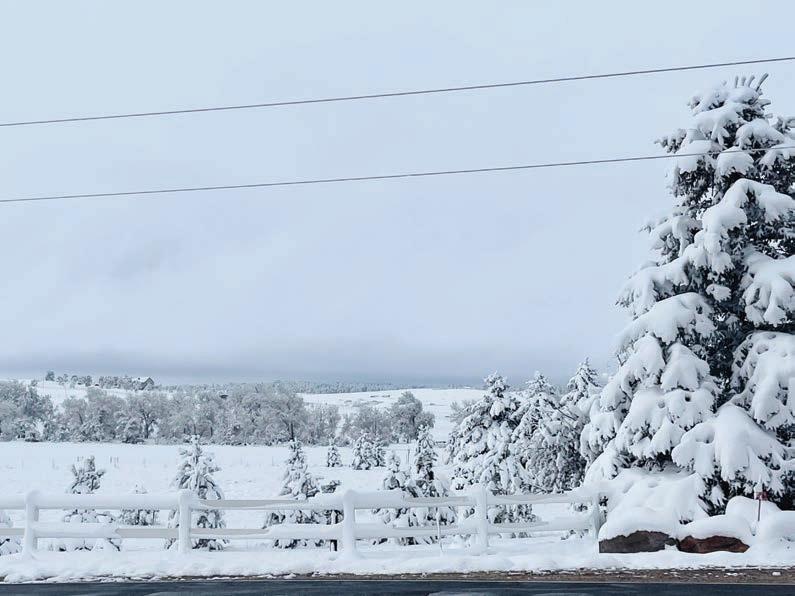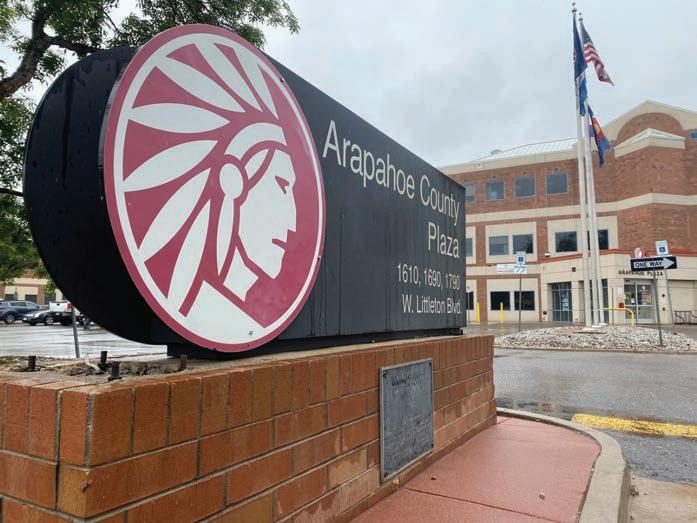
7 minute read
Weather and gas prices causing higher utility bills
BY JOSHUA PERRY AND MARK JAFFE THE COLORADO SUN
e spiking energy bills a ecting many Coloradans are caused by colder weather and higher gas prices — factors over which neither regulators nor utilities have control, the Colorado Public Utility Commission reported Wednesday.
Xcel Energy utility bills were on average 52%, or $87, higher in December than they were a year earlier, although some consumers saw their bills double, PUC Chief Economist Erin O’Neill told commissioners in a brie ng.
Commissioner John Gavan said he was struck by the magnitude of the costs and the nancial pressure they are exerting on Coloradans.
“I can’t remember seeing this level of pain in the consumer community since the 1970s and the gas crisis, which I’m old enough to remember,” he said. “So I take this very seriously.” e rising utility bills follow the approval by the commission of six electricity and gas rate hikes, several allowing for increases due to rising natural gas prices, that have spurred a near-record number of low-income consumers to seek nancial aid to pay their bills. e state-run Low-income Energy Assistance Plan has received nearly 90,000 requests for bill relief, as of Tuesday, compared with 80,000 for the same period last winter, and has issued $25 million in payments. Energy Outreach Colorado, a nonpro t that helps people with their bills, received 44,000 calls to its HEAT helpline in January. ere is a lot of pressure to do something.” e average temperature in December was about 10 degrees colder than it was in December 2021, O’Neill said, and that means more energy was being consumed to keep homes warm. Additionally, commodity prices for natural gas have increased substantially — 40% higher than last year — which is a cost that utility companies pass directly to consumers. Smart meters, recent investments in solar and wind energy, and time-of-use rates for electricity customers are not signi cantly impacting bill hikes, O’Neill said. e price of natural gas for delivery in February has dropped 26% between December and January, to 56 cents a therm, so February bills may be lower, Commissioner Megan Gilman said. But even if the bill crisis is resolved in the short term, there’s a systemic problem. e market for natural gas is unregulated, Gilman said, and fuel price spikes and severe weather events will continue to make prices and rates volatile.
“ is is an unprecedented number,” said Denise Stepto, a spokeswoman for the nonpro t. “Is it sustainable from month to month?
“We share the commission’s concerns and appreciate their e orts to provide greater insight into the causes of higher costs,” Xcel Energy said in a statement. e company said it is adding more low-cost renewable energy and securing competitively priced fuel contracts.

Natural gas continues to be the most reliable and a ordable source to heat its customers’ homes each winter, Xcel also said. e company is the largest utility provider in Colorado with 1.5 million electric customers and 1.6 million gas customers.

“What we thought were the extremes before February 2021 are not the extremes anymore,” she said.

Addressing the overarching problem is not simple. Price hikes could be spread over time — Xcel Energy is doing this over 30 months with $500 million in gas charges from

2021’s Winter Storm Uri. But that could lead to future price spikes “pancaking” on top of each other, Gilman said. e commission needs to think in the long term, she said.
While the base rates only accounted for 16% of the December increase, both Gilman and Commission Chairman Eric Blank said that the commission should focus on those rates — which they must approve. Blank said the doubling of gas base rates since 2011 didn’t signicantly impact consumers when gas prices were low.
“Now the combination of higher commodity prices and the doubling of base rates really puts us in a different world and creates much more a ordability pressure,” Blank said.
More attention should be paid to what investments utilities make before the companies come to the commission to add them to the rates customers pay.
Another concern that commissioners expressed is Xcel Energy’s lack of incentive. Blank said there ought to be an alignment of interests between the company and its customers.
“When customers lose, utilities should share some of the pain,” he said.
Gilman said that the mechanism that just passes the cost of natural gas, high or low, on to consumers is also a problem.
“Since it’s a direct pass-through, they do not have an incentive to get you more expensive gas,” Gilman said. “ ey also don’t have an obvious economic incentive to get the cheapest gas they can. So we need to ensure that they have some skin in the game.” is story is from e Colorado Sun, a journalist-owned news outlet based in Denver and covering the state. For more, and to support e Colorado Sun, visit coloradosun.com. e Colorado Sun is a partner in the Colorado News Conservancy, owner of Colorado Community Media.
While 60% of the bill increase was driven by factors the commission can’t control — gas rates and weather — PUC can still have an impact, according to Cindy Schonhaut, director of the Colorado O ce of the Utility Consumer Advocate.
“What they can focus on,” she said, “is the 40% of bills beyond the fuel charges,” such as base rates, xeduse charges and add-ons for speci c projects, like pipeline safety.
Turn To The Colorado Sun For News Across The State
The Colorado Sun is a journalist-owned, award-winning news outlet that strives to cover all of Colorado so that our state — our community — can better understand itself.
In this way, The Sun contributes to a more vibrant, informed and whole Colorado.
The Sun, launched in 2018, is committed to fact-based, in-depth and nonpartisan journalism. It covers everything
About Letters To The Editor
Colorado Community Media welcomes letters to the editor. Please note the following rules: from politics and culture to the outdoor industry and education.
• Email your letter to letters@coloradocommunitymedia.com. Do not send via postal mail. Put the words “letter to the editor” in the email subject line.

• Submit your letter by 5 p.m. on Wednesday in order to have it considered for publication in the following week’s newspaper.
• Letters must be no longer than 400 words.
• Letters should be exclusively submitted to Colorado Community Media and should not submitted to other outlets or previously posted on websites or social media. Submitted letters become the property of CCM and should not be republished elsewhere.
• Letters advocating for a political candidate should focus on that candidate’s qualifications for o ce. We cannot publish letters that contain unverified negative information about a candidate’s opponent. Letters advocating for or against a political candidate or ballot issue will not be published within 12 days of an election.

Now, The Colorado Sun co-owns this and other Colorado Community Media newspapers as a partner in the Colorado News Conservancy. The Sun is CCM’s partner for statewide news.
For Colorado Sun stories, opinions and more, and to support The Sun’s misssion as a member or subscriber, visit coloradosun.com.
• Publication of any given letter is at our discretion. Letters are published as space is available.
• We will edit letters for clarity, grammar, punctuation and length and write headlines (titles) for letters at our discretion.
• Please don’t send us more than one letter per month. First priority for publication will be given to writers who have not submitted letters to us recently.
• Submit your letter in a Word document or in the body of an email. No PDFs or Google Docs, please.
• Include your full name, address and phone number. We will publish only your name and city or town of residence, but all of the information requested is needed for us to verify you are who you say you are.
• Letters will be considered only from people living in Colorado Community Media’s circulation area in Adams, Arapahoe, Clear Creek, Denver, Douglas, Elbert, Je erson and Weld counties.
• Do not use all caps, italics or bold text.
• Keep it polite: No name calling or “mudslinging.”
Supporting local groups
BY NINA JOSS NJOSS@COLORADOCOMMUNITYMEDIA.COM
Arapahoe County has awarded over $2 million to nonpro t organizations in the region to support their work in serving the county’s at-risk and underserved populations.

After recommendations from county sta based on submitted applications, the Board of County Commissioners selected 12 organizations out of over 50 applicants for the competitive portion of program. In addition, they funded ten agencies through the safety net portion of the program, which annually supports organizations that supplement the county’s existing safety net services.
is year’s grants range from $8,000 to $400,000, according to the county’s website.
e grants aim to support work in several focus areas including transportation, food assistance, case management, substance abuse treatment, mental and behavioral health treatment, shelter, domestic violence support, a ordable housing and employment skills training, according to the website.
“ e big thing about Aid to Agencies is it’s these (agencies) help with the quick response on things because that’s what they’re built to do in those categories,” county spokesperson Anders Nelson said.
It is challenging for a county to quickly respond to all community challenges on its own, so funding nonpro ts helps the county team up with organizations that are more specialized to respond to community needs, he added.
Doctors Care, a Littleton-based healthcare nonpro t organization, received $14,888 through the competitive grant program.
“Doctors Care is very excited to once again be a recipient of the Aid to Agencies grant,” Elizabeth Hockaday, development and marketing director, said. “For us, it shows true partnership in the community to receive the grant.”
She said the grant money will go towards a new behavioral health advocate on sta and work to address social determinants of health, which is a subset cause of mental health issues.
“Receiving this grant helps to keep Doctors Care as an access point for Littleton and Arapahoe County,” she said. “It’s helping us to address the mental health crisis.” rough the safety net program, Gateway Domestic Violence Services received $300,000. e money supports all of the organization’s work, including emergency shelter services for those leaving abusive situations, an extended stay program, a court advocacy pro-
Other competitive grant recipients included Ability Connection, Integrated Family Community Services, Second Chance Center, Inc., Justice and Mercy Legal Aid Center and more.








